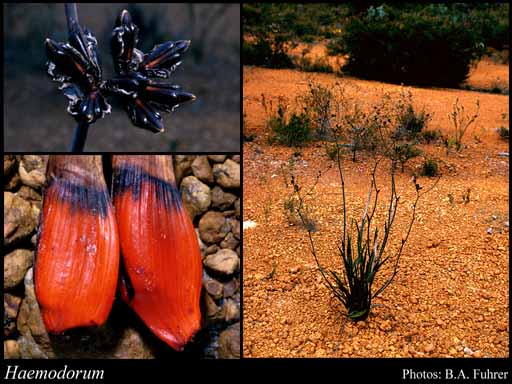- Reference
- Trans.Linn.Soc.London,Bot. 4:213 (1798)
- Name Status
- Current

Scientific Description
Common name. Blood Roots. Family Haemodoraceae.
Habit and leaf form. Herbs (erect); with coloured juice, or non-laticiferous and without coloured juice. Perennial. Leaves basal and cauline (mostly basal). Plants with a basal concentration of leaves (leaves all radical); bulbaceous (stems or rhizomes in sheathing leaf bases sometimes resemble bulbs), or rhizomatous (all subterranean parts with orange pigment, in Australian species). Rhizome and root tissues brightly red-pigmented. Mesophytic, or xerophytic. Leaves medium-sized to large; alternate; distichous; leathery; flowers aromatic; sheathing. Leaf sheaths with free margins. Leaves edgewise to the stem, or with ‘normal’ orientation; simple; epulvinate. Leaf blades entire; flat, or solid; linear (or ensiform); linear; parallel-veined; sheathing, sheath margins open. Leaves without stipules. Leaf blade margins entire. Leaves with a persistent basal meristem, and basipetal development. Vernation conduplicate. Leaf anatomy. Guard-cells not ‘grass type’. Hairs absent. Stem anatomy. Secondary thickening absent.
Reproductive type, pollination. Fertile flowers hermaphrodite. Unisexual flowers absent. Plants hermaphrodite. Floral nectaries present. Nectar secretion from the gynoecium (via septal nectaries). Entomophilous, or ornithophilous, or pollinated by unusual means.
Inflorescence and flower features. Flowers aggregated in ‘inflorescences’; in cymes (in thyrses), or in racemes (AKP), or in spikes (interrupted), or in heads (compound), or in corymbs (K), or in panicles (AKPB), or in fascicles (or clusters). The terminal inflorescence unit cymose, or racemose. Inflorescences scapiflorous; terminal; raceme simple or branched, panicle loose, corymbose or not corymbose. Flowers pedicellate; bracteate (AKB); bracteolate (K); regular; 3 merous; cyclic; tricyclic, or tetracyclic. Perigone tube present, or absent. Free hypanthium very short. Perianth of ‘tepals’; 6 (in 2 whorls); 2 -whorled; isomerous; petaloid; similar in the two whorls; green (greenish), or yellow, or orange, or red, or black (blackish). Androecial members definite in number. Androecium 3. Androecial members adnate (adnate to inner segments); all equal; free of one another; 1 -whorled. Androecium exclusively of fertile stamens. Stamens 3; all more or less similar in shape; isomerous with the perianth; oppositiperianthial. Filaments appendiculate, or not appendiculate. Anthers basifixed; versatile; dehiscing via longitudinal slits; introrse; unappendaged, or appendaged (apically, from the connective). Gynoecium 3 carpelled. The pistil 3 celled. Gynoecium syncarpous; eu-syncarpous; inferior (except for bulging tops of the locules). Ovary plurilocular; 3 locular. Gynoecium stylate. Styles 1; when 3, partially joined; from a depression at the top of the ovary; apical; much longer than the ovary at anthesis. Stigmas 1; minutely 3 - lobed; capitate. Placentation axile. Ovules 2 per locule; non-arillate; orthotropous to hemianatropous.
Fruit and seed features. Fruit non-fleshy; dehiscent; a capsule. Capsules loculicidal (by 3 spreading apical slits). Fruit 3 celled. Seeds copiously endospermic. Endosperm oily. Seeds winged. Cotyledons 1. Testa without phytomelan.
Etymology. Name used by Theophrastus and Pliny for Orobanche cruenta. Neither explains its derivation, but both refer to the parasitic nature of the plant. Applied to its current application by Sir James E. Smith who must have been aware of its ancient provenance. Has been derived from the Greek for "blood" and "gift", on account of the red roots, but this is pure supposition.
Taxonomic Literature
- Wheeler, Judy; Marchant, Neville; Lewington, Margaret; Graham, Lorraine 2002. Flora of the south west, Bunbury, Augusta, Denmark. Volume 1, introduction, keys, ferns to monocotyledons. Australian Biological Resources Study.. Canberra..